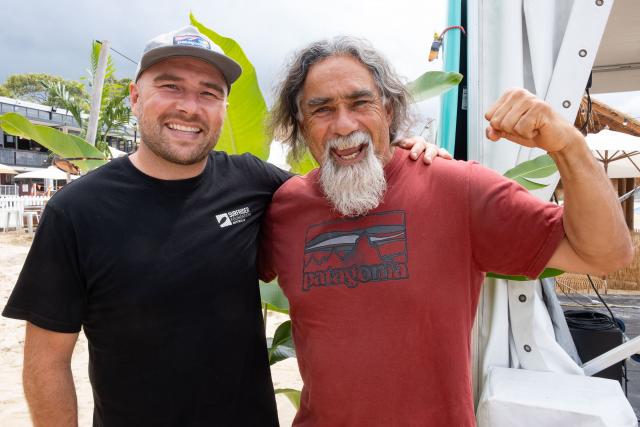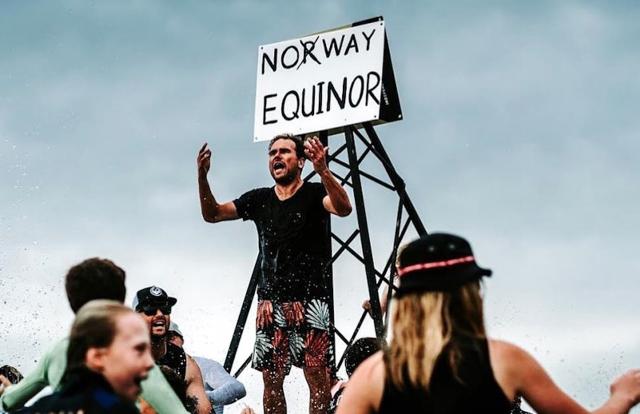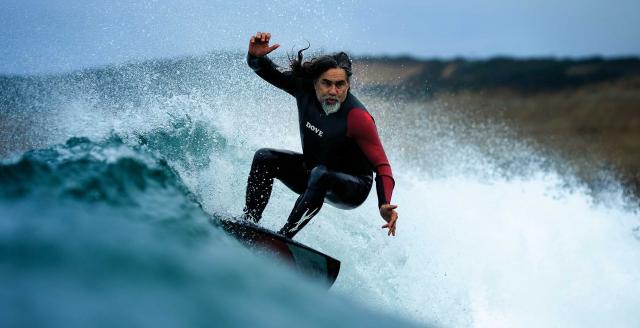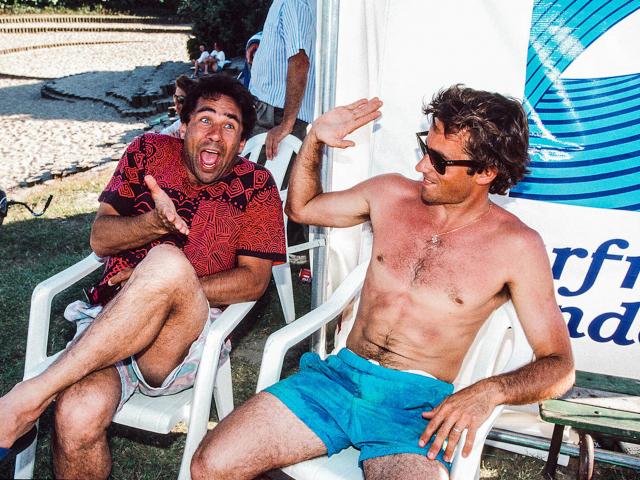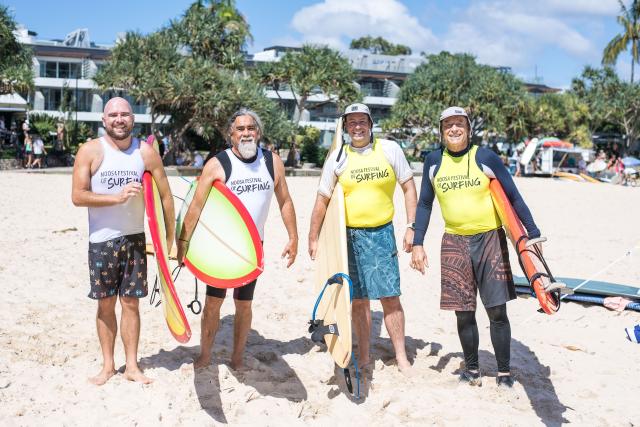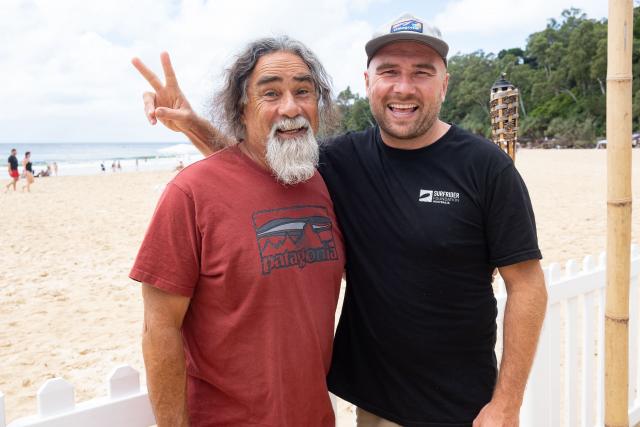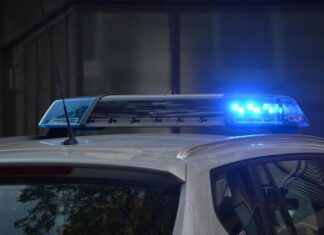Damien Cole, environmental activist and one of the main architects of the historic and successful Fight For The Bight, arrived at First Point Noosa for his heat at the Noosa Festival of Surfing the other day in a bit of a flap.
Cole, 36, wears many hats as national campaigns manager for Surfrider Foundation Australia and a principal of eco-surfboard company Varuna Surf, and he’d been busy on calls and Zoom conferences all morning while his dad, the legendary surfboard designer Maurice Cole relaxed in their Hastings Street holiday apartment.
They were about to surf as a team in the Family Challenge event, but as they prepared Cole Sr said: “I forgot the fins.”
“I got so frustrated with him I just boiled over,” Damien recalls.
“But then I just calmed myself down and thought, why am I getting worked up about this? Surely we can borrow some fins! And we could. I thought, how fortunate am I to have a dad who is an incredible surfer and surfboard designer and such an inspiration. We’re here in Noosa and I get to surf out there with my hero, my dad.
“We walked down the beach and had a hug before we paddled out, and I think that was the moment I realised how important this was in both our lives.”
While Damien’s battle against Norwegian energy company Equinor’s proposal to deep water drill for hydrocarbons in the Great Australian Bight and his two runs at political office as an eco-warrior independent have propelled him into the frontline of the environmental movement, Maurice, who turned 68 last weekend, has been fighting for his life, successfully battling cancer and diabetes.
I’ve known Maurice for almost 50 years, and I can tell you, no one is better equipped for a fight than the passionate, volatile and fearless surfing legend. Whether it’s towing into a monster wave in Hawaii, leading a protest march against French nuclear testing in the Pacific, or taking the rap for others and doing hard time at Pentridge on drug charges, somehow you know he’ll come out onto the green shoulder undaunted.
Maurice Cole was born in Terang, western Victoria in 1954, and immediately adopted by the Coles, staunch Anglicans from Ballarat, beginning a sequence of events that would create a genetic puzzle he still hasn’t solved. When the Coles moved to the coast at Warrnambool in 1960, young Maurice discovered the beach, but it would be another six years before he took up surfing.
It soon became his life’s passion, and by 1971 he was shaping surfboards in Torquay, the capital of Victorian surfing and birthplace of Rip Curl and Quiksilver.
As well as progressing as a shaper and designer, Maurice was soon a champion surfer, making national finals and winning two Victorian state titles before being stripped of them by the governing body after his 1976 drug convictions.
As editor of Tracks surfing magazine at the time, I campaigned, alongside our art director Stephen Cooney, for Cole’s reinstatement. Reunited in Noosa after many years, the three of us sat in the festival beach bar last week and shared some laughs over those crazy times.
By the late ‘80s, Maurice was an internationally recognised surfboard designer working with a string of world champion clients, based with his wife and young family in Hossegor, France. It was during this period that he formed a close relationship with the enigmatic young Californian surfer Tom Curren, who was also living in France. Riding a quiver of MC custom shapes, Curren charged his way to his third world title in 1990.
During that title campaign he and his gun shaper were driving home from the Lacanau Pro one night when Maurice leaned into him and said: “This place has given us both so much – what can we do for France?” The answer was to form Surfrider Foundation Europe, following the model of the US Surfrider, created in 1984 to protect beaches around the world.
Curren became the first ambassador for Surfrider Europe, a role he still has today.
While fighting environmental threats in France was the first priority, Surfrider and Cole soon became embroiled in a much bigger fight. After decades of nuclear testing in the Pacific, creating environmental devastation in its wake, in 1991 France bowed to international pressure and began a moratorium, but within a couple of years French President Jacques Chirac resumed the testing.
Cole and Curren set up Surfers Against Nuclear Explosions (SANE) and during a world championship event in Hossegor, they led a march on the Deputy Prime Minister’s holiday house by the lake, six-year-old Damo by his side.
Maurice remembers: “From that point on Damien was involved in the environment movement.”
Says Damien: “I remember feeling that sense of responsibility, and that as surfers we needed to look after our own place. That’s how I was brought up, to always look after the ocean because it always looks after us.”
As the Cole kids grew up, moving around the world following demand for their father’s designs, Damien made a conscious decision to get out from under the shadow of his larger-than-life dad and follow his own path.
He spent years in construction and the mining industry before seeing the light and returning to the ocean. In 2015 he began a course in environmental science, and got heavily involved with local community groups, ultimately leading to his role in the paddle-out protests that won the Battle of the Bight.
Although at the peak of his career Maurice Cole was said to have made more than $1 million a year, by this time his fortunes had changed. An ambitious surfboard co-operative called BASE had failed with a multi-million-dollar trail of debt, he was fighting cancer and depression, and he was grappling with DNA testing being unable to find the Aboriginal antecedents he’d believed were his since early childhood, when “I was the only blackfella in my class”.
While Damo had found his way, Maurice was struggling, and that was reflected in a new phase of an always-loving father/son relationship.
Says Damien: “My dad was a huge influence on me for the first 25 or even 30 years. After that it probably changed a bit to where we talk on a level playing field now. We have long discussions about the issues and we definitely don’t agree on everything, but that’s levelled out over the last five or six years as I’ve developed my skills.”
When Damien took the environmental fight to the political stage and contested the Victorian seat of Corangamite as an independent, Maurice says he made a conscious decision to pull back from the front line.
“I decided to watch my son do this by himself, to get out from my shadow. He got to the last few days [of the campaign] and the wheels started to fall off, and that’s when you’ve got to be there to catch them and take care of them.”
Damien: “The most loving thing he did was to turn up at the pre-election polling booth and say to me, I’m here, what do you need? I said I needed some food and a pair of shorts and he came back half an hour later with both. He wasn’t trying to tell me how to do anything, it was just pure support.”
Maurice: “That’s me learning from him. We’ve always had a strong bond but from a father’s perspective, the hardest thing to do is let your kids fall over, to let them make their mistakes. Damo and I have disagreements, meltdowns, no punch-ups fortunately because I’m too old and weak now.”
Damien: “It’s by no means a perfect relationship but what makes our bond so strong is that we can come back an hour or a week after a blow-up and make things right. Communication is the key, and we have that.”
Surfing together as a team in Noosa last week for the first time ever put a new seal on that relationship. Says Maurice: “It was a very emotional thing for both of us, but particularly for me. I’ve been close to death over the past couple of years, and Damo lived through that with me on a day to day basis, so when the opportunity arose to join in this wonderful event, we jumped on it.”
And the identity issue? Having grown up believing himself to be an Indigenous Australian, and having spent much of his adult life with close relations to several mobs around the country, Maurice now finds that the DNA evidence is inconclusive.
His good friend Professor Lennie Collard, a Whadjuck Nyoongar elder and academic on Rottnest Island, told him: “Don’t worry about it, you’re one of us”. For now, that’s good enough for Maurice.
He says: “I guess one way of looking at it, and this is a thing I’ve discussed with my sisters, when we hear bagpipes, nothing tugs at the heart. When we hear didgeridoo, it stops us in our tracks. To me it’s about defining what an Australian is. The European colonial culture has only been here for a couple of centuries. The original Australian culture has been here for 50,000 years. Regardless of who or what we think we are, we need to embrace that first culture and appreciate and nurture it.”

